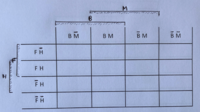Zermelo
Junior Member
- Joined
- Jan 7, 2021
- Messages
- 148
Hello,
currently I'm working with the Inclusion and Exclusion principle in my Discrete Math class (didn't know where to put the thread, probability seemed the best choice, correct me if I'm wrong). The problem goes like this:
B = 12, M = 20, F = 20, H = 8, B&M = 5, B&F = 7, B&H = 4, M&F = 16, M&H = 4, H&F = 3, B&M&F = 3, B&M&H = 2, B&F&H = 3, M&F&H = 2, B&M&F&H = 2, Bc & Mc & Fc & Hc = 71.
The big letters represent number of elements in those sets, & represents the set intersection (the whole expression A&B&C is the number of elements in the set intersection), and c represents the complement (it's not mathematically correct, it would take a lot of time to print it out in LaTeX, I'm sorry, but you get what I meant).
The first question is, how many elements are there in total? I solved this easily, the Inclusion exclusion principle generalizes well, and I got S = 100 directly from the principle.
The problem is with the second question, "how many elements are there JUST in set B"? ; aka, B & Mc & Hc &Fc = ?
When I did this problem with 3 sets, I could easily draw a Venn diagram, and the answer would just pop up. For example, for 3 sets A,B,C, A* = A - A&B - A&C + A&B&C.
(A* is the set A&Bc&Cc, aka number of elements in that set.)
But, here drawing Venn diagrams is a lot more complicated. I did it anyway, and god an answer of B* = 6, I would be really grateful if someone could check it, because it's really complicated. Apart from that, I want to know if there is a simpler way of doing this instead of drawing 4 set Venn diagrams (which are really complicated), is there a way to use the Inclusion Exclusion principle on this particular problem?
Thanks in advance.
currently I'm working with the Inclusion and Exclusion principle in my Discrete Math class (didn't know where to put the thread, probability seemed the best choice, correct me if I'm wrong). The problem goes like this:
B = 12, M = 20, F = 20, H = 8, B&M = 5, B&F = 7, B&H = 4, M&F = 16, M&H = 4, H&F = 3, B&M&F = 3, B&M&H = 2, B&F&H = 3, M&F&H = 2, B&M&F&H = 2, Bc & Mc & Fc & Hc = 71.
The big letters represent number of elements in those sets, & represents the set intersection (the whole expression A&B&C is the number of elements in the set intersection), and c represents the complement (it's not mathematically correct, it would take a lot of time to print it out in LaTeX, I'm sorry, but you get what I meant).
The first question is, how many elements are there in total? I solved this easily, the Inclusion exclusion principle generalizes well, and I got S = 100 directly from the principle.
The problem is with the second question, "how many elements are there JUST in set B"? ; aka, B & Mc & Hc &Fc = ?
When I did this problem with 3 sets, I could easily draw a Venn diagram, and the answer would just pop up. For example, for 3 sets A,B,C, A* = A - A&B - A&C + A&B&C.
(A* is the set A&Bc&Cc, aka number of elements in that set.)
But, here drawing Venn diagrams is a lot more complicated. I did it anyway, and god an answer of B* = 6, I would be really grateful if someone could check it, because it's really complicated. Apart from that, I want to know if there is a simpler way of doing this instead of drawing 4 set Venn diagrams (which are really complicated), is there a way to use the Inclusion Exclusion principle on this particular problem?
Thanks in advance.

